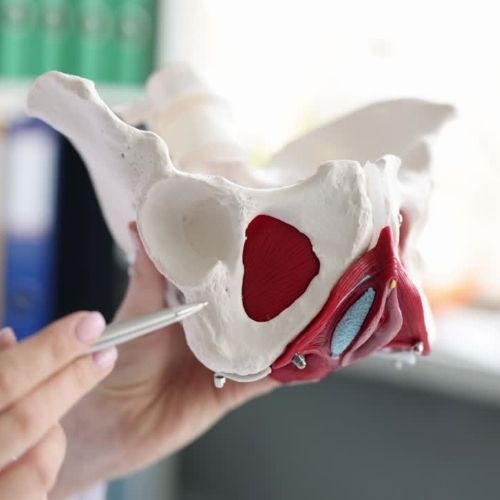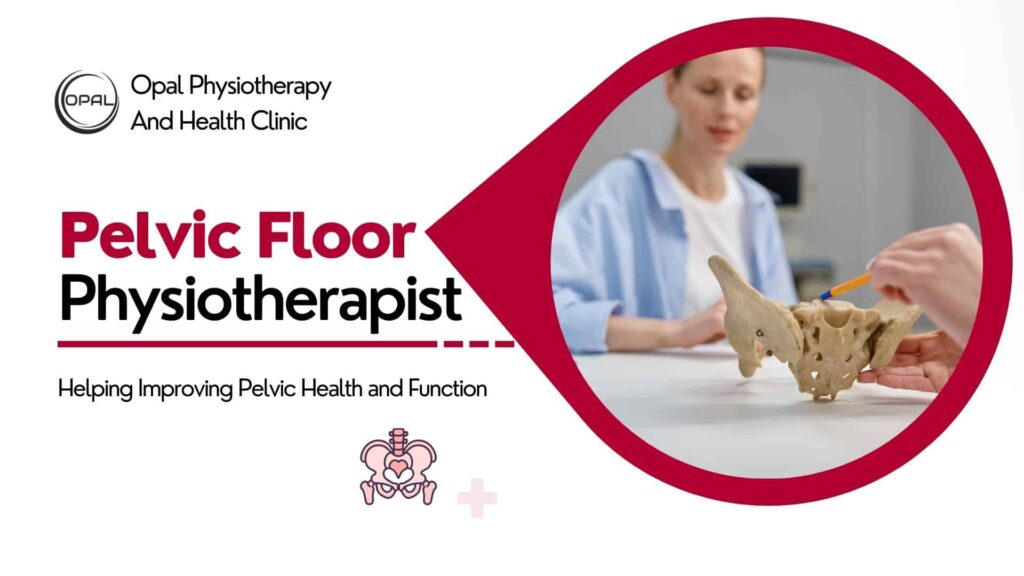Pelvic Floor Physiotherapy Services

Women’s and Men’s Pelvic Floor Physiotherapy
At Opal Physiotherapy, our registered pelvic floor physiotherapists have a particular interest and extensive post-graduate training in managing pelvic floor dysfunction in men and women.
All assessment and pelvic health treatment sessions are one-on-one and conducted in a private and supportive environment. Our pelvic floor physiotherapists are trained to perform internal examinations, external pelvic floor assessments, and manage pelvic floor conditions.
How does pelvic floor physiotherapy treatment work?
Our pelvic floor physiotherapy treatment in Langley may include specific exercises to strengthen or relax pelvic floor muscles, motor control and core muscle re-training, visceral and somatic and scar mobilization techniques, education and lifestyle modifications.
Pelvic Health Physiotherapy
Pelvic health physiotherapy is a popular treatment for men and women with incontinence issues, painful sexual intercourse, and other disorders of the pelvis. Pelvic health physiotherapy can help you to reduce or eliminate your pelvic floor issues and symptoms, improve your physical and sexual functioning, and increase your quality of life.
Pelvic physical therapy has been proven to be effective in treating pelvic floor dysfunction, particularly when compared to the usual course of conservative treatment or even surgery, which can have a high recurrence rate. Pelvic Health Physiotherapy is done by highly trained physical therapists who have undergone additional training and certification in treating pelvic floor dysfunction.

Pelvic floor physiotherapy services are provided for the following conditions:

What to expect during my pelvic floor physiotherapy session?
A typical session with a pelvic floor physiotherapist involves gathering information about your history concerning your pelvic health, discussing your current problems and symptoms, and then performing some physical assessment of your pelvis, pelvic floor, and its surrounding areas as required with internal and external assessment.
Your pelvic floor therapy consultation is all conducted in private rooms and is one-on-one.
* Protecting your privacy and confidentiality is important to us *
This initial assessment will help provide very useful information about your pelvic floor muscle tone and strength and guide the proper pelvic physiotherapy treatment. However, this will always be done only with your informed consent and is conducted in a private and supportive environment.
If you are uncomfortable with internal pelvic floor assessment, an alternate way of assessment and treatment can also be discussed with you.
After the examination, your pelvic physiotherapist will discuss the assessment findings and can discuss treatment options tailored for you. Treatment may include simple exercises designed to strengthen your pelvic muscles, manual techniques and home management.
A Comprehensive Guide To Pelvic Floor Physiotherapy
Pelvic floor physiotherapy is an effective treatment option for people who want to overcome pelvic disorders. This guide will be useful for patients and healthcare providers.
Most people are familiar with core muscle training and abdominal exercises regarding the low back or pelvis, but few have heard of pelvic floor physiotherapy (PFP). Pelvic floor muscles are some of the strongest muscles in our body and help support the pelvic organs, aid sexual function, and keep the bladder and bowel functioning under control.

Pelvic Floor Physiotherapy Services: Improving Pelvic Health and Function
Pelvic floor physiotherapy is a specialty of physiotherapy that focuses on the musculoskeletal structures in the pelvis and pelvic floor. It is a specialized branch of physical therapy treatment for various pelvic conditions that aims to restore normal pelvic floor function.
Pelvic floor physio focuses on treating pelvic health disorders, including weak pelvic floor muscle or tight muscles and has been an effective treatment option for patients with pelvic pain, pelvic organ prolapse, stress or urgency urinary or fecal incontinence, and overactive bladder.
Pelvic floor physiotherapy is an invaluable treatment for men and women with urinary incontinence, urge incontinence, pelvic pain and other pelvic health dysfunctions.
This type of physiotherapy is usually performed by a certified physiotherapist specializing in pelvic floor problems. Pelvic floor physio professionals are usually trained to work with male and female patients who experience various pelvic health disorders, from urinary and fecal incontinence to pain during intercourse, urinating, or defecating.
Pelvic floor rehabilitation is a part of physiotherapy, using exercises at a low level/low load to improve everyday function to a higher level for training athletes having pelvic floor problems. Pelvic floor muscle training after a pelvic floor dysfunction helps restore pelvic floor muscle function, improve strength and stability, and improve the individual’s quality of life.
Pelvic floor physiotherapy is often prescribed as part of a treatment plan for women who have given birth and are experiencing weak muscles in the pelvis and postpartum stress incontinence. It is also prescribed for men experiencing pelvic floor issues or any other condition affecting the pelvic area.

Pelvic Floor Physiotherapy Can Help Treat Pelvic Floor Issues In Men And Women.
Pelvic floor therapy has long been known for improving and maintaining pelvic muscle strength and function to improve women’s ability to control urinary incontinence. Recent research has shown that this knowledge goes far beyond urinary incontinence.
Many think pelvic floor physical therapy is a relatively new treatment option; however, it has existed for quite a long time. Pelvic floor muscle training is traditionally recommended for women to improve urinary and bowel incontinence.
However, men are also at risk of developing pelvic muscle problems, leading to pelvic pain, incontinence, and sexual dysfunction. It is important that men need to seek pelvic floor physiotherapy treatment at the earliest to avoid any chronic issues.
Pelvic Floor Muscles
The pelvic floor muscles (PFM) are specialized muscles around the pelvic region. It is a group of muscles and connective tissues that form a structure that supports the pelvic organs. The pelvic floor muscles are connected to the pubic bone in the front, the tailbone at the back, and the sitz bones on either side.
These muscles maintain continence and bladder or bowel control in both men and women. The pelvic muscles are in layers that include the Levator ani, which comprises the three major muscle parts: pubococcygeus, puborectalis and iliococcygeus. Coccygeus, or the ischiococcygeus, is a muscle behind the levator ani muscles. The Levator ani and coccygeus muscles together form the pelvic diaphragm.
The pelvic floor muscles have many vital functions, including supporting the bladder and uterus; they help control urination and bowel movement to maintain continence. They can also help maintain vaginal tone in women and sexual function in men and women.
Pelvic Floor Dysfunction
Pelvic floor dysfunction (PFD) is caused by abnormal function of the pelvic floor muscles. It is a condition that affects many women and men of all ages. Tight or weak PFM might cause it, contributing to urinary or bowel incontinence, constipation, pelvic pain, and also experiencing the frequent need to pee.
PFD is typically treated with pelvic floor physical therapy, which focuses on exercises for strengthening the muscles and relaxation techniques to lengthen tight muscles.
There are many pelvic disorders, though all typically have some common symptoms. These include incontinence, sexual dysfunction, painful intercourse, and chronic pain. Symptoms may vary depending on the type of pelvic dysfunction.
Pelvic Floor Dysfunction Affecting Men And Women
Pelvic floor disorders can affect both men and women, although it is more common in women.
For women, pelvic floor dysfunction can cause incontinence, difficulty urinating, and sexual dysfunction. For men, it can cause difficulty urinating, sexual dysfunction, and testicles or penile pain.
In both sexes, pelvic floor dysfunction can cause pain in the lower back, hips, and thighs.
Pelvic floor dysfunction can be caused by pregnancy, childbirth, or other factors such as aging, obesity, chronic cough, constipation, heavy lifting, prolonged sitting, diabetes, neurological conditions, stress, trauma, surgical procedures, or certain medications.
Symptoms Of PFD Include
Pelvic floor dysfunction is a condition that can cause a range of symptoms
- Pelvic pain – can be a constant or intermittent pain experienced in the pelvic region.
- Difficulty urinating or having a bowel movement.
- Urinary incontinence – leakage of urine with coughing, sneezing, or other physical activities
- Urinary frequency – needing to pee frequently
- Fecal incontinence – leakage of stool or difficulty controlling bowel movements.
- Sexual dysfunction – includes pain during intercourse, difficulty achieving orgasm, premature ejaculation or loss of sexual sensation.
- Difficulty with bowel movements or constipation and a feeling of incomplete evacuation
- Pelvic organ prolapse
Treatment by our physiotherapist specializing in pelvic floor health may involve manual therapy, exercises, Kegels and lifestyle modifications. Pelvic floor exercises are often used in conjunction with other treatments, such as bladder training and biofeedback techniques.

Pelvic Floor Physiotherapy Treatment
Pelvic floor physiotherapy is a safe and effective treatment option for many people. It can offer a range of benefits, including improved urinary and bowel continence, reduced pelvic pain, low back pain and improved sexual function.
The pelvic floor treatment plan is individualized and can include various techniques to strengthen the muscles and improve their function. These can include:
1. Pelvic Floor Muscle Exercises
Pelvic floor muscle exercises like Kegels are the most common form of treatment for PFM and involve repeatedly contracting and relaxing the muscles. This can be done actively or with the help of an electrical device.
Pelvic floor exercises are usually combined with other muscle training, including core muscle and functional re-training, to improve the pelvic floor muscle’s overall function and performance.
2. Electrical Stimulation
Electrical stimulation involves the use of low-voltage electrical current to stimulate the muscles. This can help to increase muscle strength and improve function. This can be done externally with leads or internally using a probe by a pelvic therapist to the pelvic muscles, vaginal or rectal, to help improve PFM performance.
3. Manual Therapy
Manual therapy involves muscle stretching and mobilization. Manual facilitation or release of internal PFM and manipulating the external muscles, connective tissue, ligaments, and tendons in the pelvic area. This treatment by pelvic floor physical therapist can help relieve pelvic muscle pain and improve bladder and muscle function.
4. Biofeedback.
Biofeedback is a technique that uses sensors to measure the activity of the pelvic muscles. This information is then displayed on a screen to see how well the muscles contract and relax. This can help you identify which muscles are being activated during exercises, allowing you to strengthen them further to improve your muscle control.
5. Breathing Techniques.
Breathing exercises are incorporated for pelvic floor muscle function that employs breathing techniques to lengthen or strengthen the PFM. Childbirth, aging, prostate problems, and other medical conditions often weaken the PFM.
Breathing techniques can be used during the day while sitting, lying down, or walking. Breathing exercises involving the PFM can help you regain control of your muscles and reduce pain.

Pelvic Floor Rehabilitation
Pelvic floor rehabilitation physical therapy is used to treat problems with the muscles and tissues of the pelvis.
Pelvic rehabilitation may also be recommended to pregnant women who have recently given birth to help them recover from the stresses of pregnancy and childbirth.
Pelvic floor rehabilitation is a collection of treatment strategies, including physical exercises, education and behavioural changes, that can help address the symptoms and prevent pelvic floor disorders in men and women.
- The exercises help to strengthen the pelvic floor muscles, which can improve or eliminate symptoms of pelvic floor dysfunction. Pelvic floor rehabilitation uses exercises at a low level/low load to improve everyday function to a higher level for training athletes having pelvic issues.
- Education about pelvic anatomy and function can help people better understand the causes of their symptoms and how to manage them best.
- Behavioural changes, such as bladder retraining, hydration, avoiding constipation and managing stress, can also help to reduce symptoms.
Pelvic floor rehabilitation may be needed for people who have had surgery to repair an injury of the pelvic floor, such as with childbirth in women or injury after prostate surgery in men. Pelvic floor rehabilitation may also be needed for people who have experienced conditions such as overactive bladder or have symptoms that affect the function of their pelvic muscles.
This is achieved through pelvic floor muscle training, which helps restore pelvic floor muscle function, improve strength and stability, and enhance the individual’s quality of life.
Benefits Of Pelvic Floor Physiotherapy
Pelvic floor physiotherapy can offer a range of benefits for both men and women. It can help to:
- Improve pelvic floor muscle function and strength with pelvic muscle retraining
- Improve urinary and bowel function
- Reduce pelvic pain, painful bladder syndrome, Interstitial Cystitis
- Recover from chronic pelvic pain
- Treat sexual dysfunction
- Prepare the body for childbirth
- Help with postpartum care and recovery
- Prevent prolapse of the pelvic organs.
- Improve your muscle performance during daily tasks.
Frequently Asked Questions On Pelvic Floor Physiotherapy:
Below are some common questions and answers you might have regarding pelvic floor physiotherapy treatment to help improve your life quality.

About Us
We are passionate pelvic floor physio professionals who believe in providing quality care to our clients. We provide a full spectrum of care, from prevention to rehabilitation. We aim to get you back to doing the things you love safely and without pain.
We provide Pelvic floor physiotherapy services in and around Langley, Langley Twp, Coquitlam, Surrey, Delta, Richmond, Vancouver, Burnaby, Maple Ridge, White Rock and Abbotsford, BC.
